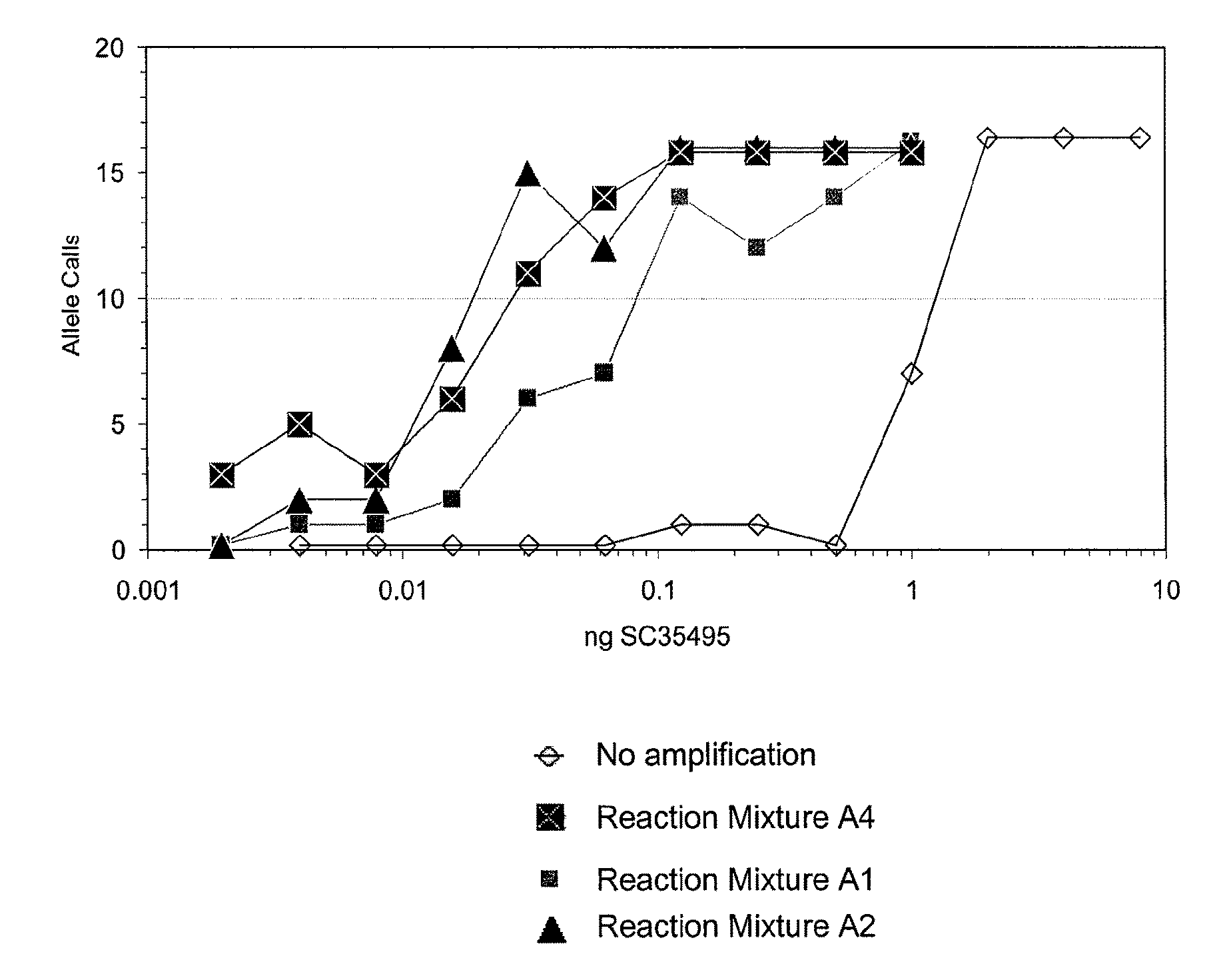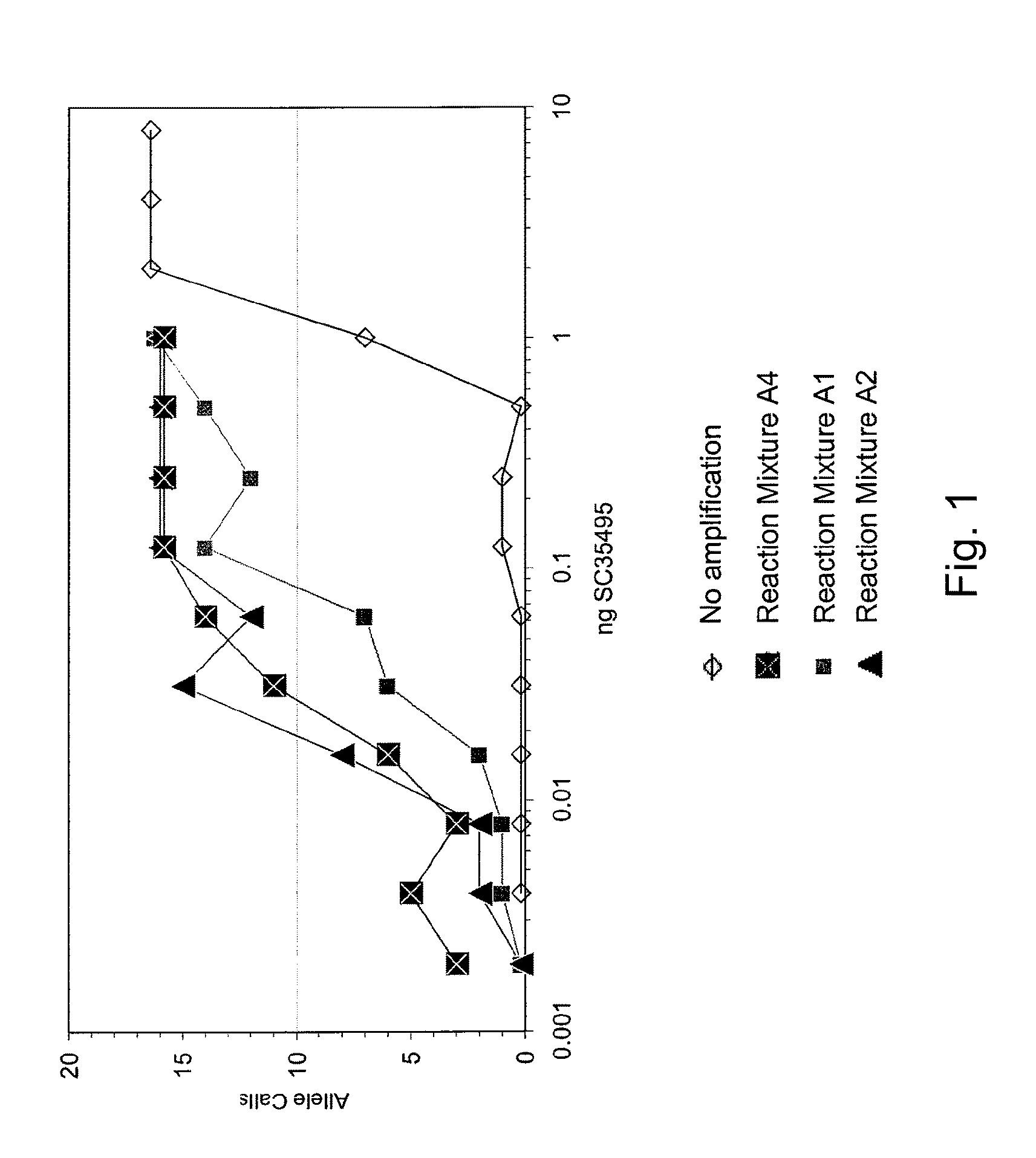Multiple displacement amplification
a technology of multiple displacement and amplification reaction, which is applied in the field of multiple displacement amplification reaction, can solve the problems of incomplete genome coverage, inability to amplify certain sequences, and severely limit the type and quantity of genomic dna, so as to improve the sensitivity of various dna analysis methods and achieve efficient yields of amplified nucleic acids
- Summary
- Abstract
- Description
- Claims
- Application Information
AI Technical Summary
Benefits of technology
Problems solved by technology
Method used
Image
Examples
example 1
Effects of Compatible Solutes on Sensitivity of Amplification Reaction
[0123]The purpose of this series of experiments was to investigate the effects of the compatible solutes trehalose and betaine on enhancement of the sensitivity of the amplification reaction where sensitivity reflects the ability to successfully amplify the target DNA at low concentrations below the 1 nanogram level.
[0124]Initial investigations indicated that the concentration of trehalose that provides an optimal increase in sensitivity of the amplification reaction was approximately 0.8 M, as indicated in an amplification reaction of 50 picograms of human DNA, followed by a calculation of the percentage of alleles detected in analysis of the amplified DNA obtained in the reaction. Likewise, the optimal concentration of betaine was found to be approximately 0.8 M.
[0125]In order to investigate the effects of compatible solutes on the sensitivity of the amplification reaction, amplification reaction mixtures were d...
example 2
Effects of Compatible Solutes on Maintaining Allelic Balance in the Amplification Reaction
[0135]Allelic balance is a measure that indicates the ratio of quantity of detection of the minor allele vs. the major allele. It is desirable to maintain the allelic balance of a given sample of DNA as it is amplified in order to provide an accurate representation of the allelic balance in the original sample.
[0136]A human DNA sample designated SC35495 was amplified according to conditions described in Example 1. In this example, the amounts of the alleles detected were quantified using the commercially available kit Quantifiler™ (Applied Biosystems). The quantity values were converted to Log2 to provide a more intuitive measure of balance. These values are shown in FIG. 2, where it can be seen that mixture 3 (A4) is the best mixture for maintaining the best representation of the allelic balance. This indicates that inclusion of compatible solutes betaine and trehalose to the reaction mixture ...
example 3
Effects of Compatible Solutes on Maintaining the Quality of the Amplification Reaction
[0137]The quality of the amplification reaction can be described in terms of providing a combined measure of optimal fold amplification, a high percentage of amplification of the target nucleic acid being analyzed, and optimal performance in the Profiler™ assay.
[0138]Shown in FIG. 3 are the results of the determinations of quantity of template DNA amplified by the three reaction mixtures according to the conditions described in Example 1 using 0.1 nanograms of template DNA (panel A) and 1 nanogram of template DNA (panel B). It is clear that mixture 3 (A4) produces the most amplified DNA. Furthermore, it was found that mixture 3 (A4) produces fewer extraneous non-template peaks detected in the Quantifier™ assay (not shown) and in 1% agarose gels (not shown) than observed for the other two mixtures. Thus, the inclusion of betaine and trehalose in the reaction mixture significantly improves the qualit...
PUM
| Property | Measurement | Unit |
|---|---|---|
| Fraction | aaaaa | aaaaa |
| Molar density | aaaaa | aaaaa |
| Molar density | aaaaa | aaaaa |
Abstract
Description
Claims
Application Information
 Login to View More
Login to View More - R&D
- Intellectual Property
- Life Sciences
- Materials
- Tech Scout
- Unparalleled Data Quality
- Higher Quality Content
- 60% Fewer Hallucinations
Browse by: Latest US Patents, China's latest patents, Technical Efficacy Thesaurus, Application Domain, Technology Topic, Popular Technical Reports.
© 2025 PatSnap. All rights reserved.Legal|Privacy policy|Modern Slavery Act Transparency Statement|Sitemap|About US| Contact US: help@patsnap.com



